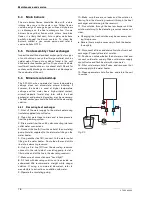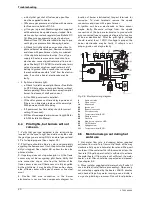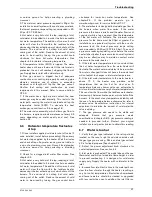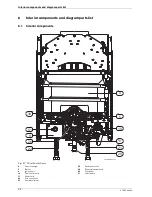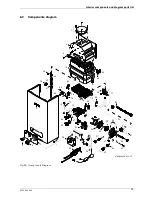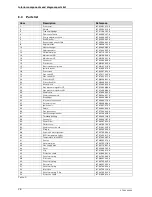
6 720 644 942
18
Maintenance and service
5.4
Main burners
The main burner flames should be blue, with a more
intense blue cone in the center core. Yellow flames
could be a sign of wrong size gas orifices, dirty burners
or a blockage on the heat exchangers fins. If some
burners have yellow flames while others have blue
flames, it is likely that dust, lint or spider webs have
partially clogged the burner venturis. To clean the
burners, contact a gas service person and refer to
service bulletin CT-13.
5.5
Vent assembly / heat exchanger
Inspect the draft hood and heat exchanger fins for signs
of soot build-up or any other foreign material such as
spider webs. Clean out any debris found in the vent
hood and/or heat exchanger fins. Signs of soot indicate
insufficient combustion air or exhaust draft. Check for
vent assembly blockage or combustion air blockage on
the underside of the unit.
5.6
Mineral scale build-up
The 520 HN, when operated at lower temperatures
settings, does not accumulate mineral build-up. If
however, the heater is used at higher temperature
settings and the water has a high mineral content,
mineral deposits (scale) may form within the heat
exchanger and periodic descaling may be necessary.
The heat exchanger should be flushed with a descaling
solution.
5.6.1
Descaling heat exchanger
1. Shut off the water supply to the water heater using
(installer supplied) shut-off valve.
2. Open hot water taps to drain and relieve pressure
from the plumbing system.
3. Drain water from the unit by disconnecting inlet and
outlet water connections.
4. Connect the line (A) from the outlet of the circulating
pump (installer supplied) to the inlet water fitting on the
water heater.
5. Using another line (B), connect to the water outlet
fitting on the water heater. Route the other end of this
line into a descaling reservoir.
6. Using a 3rd line (C) from the descaling reservoir,
connect to the inlet side of circulating pump. Install a
filter on the end of the line in the descaling reservoir.
7. Make sure all connections are "hand tight."
8. Fill tank with descaling solution so lines inside are
submersed. We recommend a straight white vinegar
solution. If using a commercial descalant, refer to
manufacturer's instructions on dilution with water.
9. Operate the circulating pump.
10. Make sure there are no leaks and the solution is
flowing from the descaling reservoir through the heat
exchanger and returning to the reservoir.
11. Run solution through the heat exchanger until the
solution returning to the descaling reservoir comes out
clear.
B
Changing to a fresh solution may be necessary dur-
ing this process.
B
Several hours may be necessary to flush the heater
thoroughly.
12. Disconnect all lines and drain all solution from heat
exchanger. Properly discard of solution.
13. Position a container below the hot water outlet and
connect cold water supply. Open cold water supply
shut-off valve and flush heater with clean water.
14. Shut cold water shut-off valve and reconnect hot
water supply to the water heater.
15. Open open water shut-off valves, and return the unit
to service.
Fig. 25















